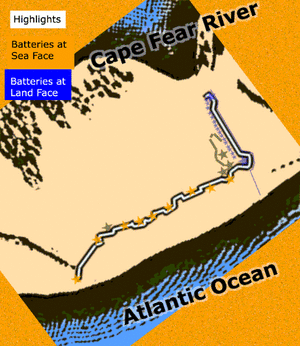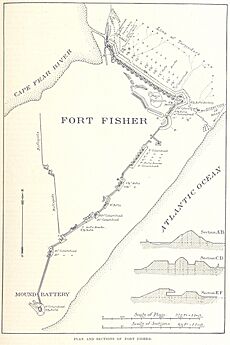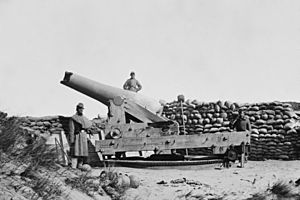Fort Fisher facts for kids
Quick facts for kids Fort Fisher |
|
|---|---|
| New Hanover County, near Wilmington, North Carolina | |

Union Attack on Fort Fisher, North Carolina, January 15, 1865
|
|
| Site history | |
| Built | 1861 |
| In use | 1861–1865 |
| Battles/wars | First Battle of Fort Fisher Second Battle of Fort Fisher |
| Events | |
|
Fort Fisher
|
|
| Lua error in Module:Location_map at line 420: attempt to index field 'wikibase' (a nil value). | |
| Nearest city | Wilmington, North Carolina |
| Area | 200 acres (81 ha) |
| Built | 1861 |
| Architect | Lamb, Col. William |
| NRHP reference No. | 66000595 |
| Added to NRHP | October 15, 1966 |
Fort Fisher was a very important Confederate fort during the American Civil War. It protected the busy trading port of Wilmington, North Carolina, from 1861 until the Union army captured it in 1865. The fort was located on a piece of land called Federal Point, which is now known as Pleasure Island. Because Fort Fisher was so strong, people called it the Southern Gibraltar. The battles at Fort Fisher were some of the most important in North Carolina during the Civil War.
Contents
Why Fort Fisher Was Important
Wilmington: A Key Port
The city of Wilmington is about 21 miles (34 km) up the Cape Fear River from the Atlantic Ocean.
During the Civil War, Wilmington was a main entry point for supplies for the Confederacy. Ships brought in important goods like munitions, clothing, and food. In return, the South sent out cotton and tobacco. This trade helped the southern states and General Robert E. Lee's army in Virginia.
British ships, called blockade runners, helped with this trade. They were fast steamships that tried to avoid the Union's naval blockade of Confederate ports. Most of these ships came through British colonies like Bermuda or the Bahamas.
After the Union captured Norfolk, Virginia, in 1862, Wilmington became even more important. It was the main Confederate port on the Atlantic. Thanks to Fort Fisher, Wilmington's defenses were very strong, allowing it to stay open for a long time during the war.
The Cape Fear River's Defenses
South of Wilmington, along the last 20 miles (32 km) of the Cape Fear River, several Confederate forts and batteries protected the ships. The river channel also had underwater traps, called "torpedoes" (which were actually mines). Confederate officers carefully guided ships through these dangers.
At the mouth of the Cape Fear River, there were many Confederate defenses. The river flowed into the sea through two shallow inlets, separated by Bald Head Island. Having two inlets was a big advantage. Blockade runners could switch between the inlets to avoid Union ships.
Early in the war, the Confederacy took control of the Federal Point peninsula. This spot was perfect for defending the Cape Fear River's "New Inlet."
Fort Fisher's History
Building the First Defenses
The first cannons were placed in the spring of 1861, about 1 mile (1.6 km) from the New Inlet. Major Charles Pattison Bolles oversaw this work. The area was first called "Bolles Battery."
Later, the fort was officially named "Fort Fisher" in September 1861. It was named after Colonel Charles Frederick Fisher, a brave officer who died in the First Battle of Manassas.
The area around the fort had few people, mostly small farms and pine forests. Confederate pilots would climb tall pine trees to spot incoming blockade runners. Then, they would go out to guide the ships safely past the defenses to Wilmington.
Fort Fisher was later made even stronger with powerful cannons from Charleston. These cannons forced Union blockade ships to stay far offshore, too far to shoot at the fort.
Making the Fort Stronger
In July 1862, Colonel William Lamb took command of Fort Fisher. He quickly saw that the fort needed a lot of work. Since Wilmington was so important for trade, its defenses had to be very strong.
Workers built a line of earth mounds called the Land Face, which stretched to the sea. Later, the Sea Face was built along the coast. Where these two faces met, a tall structure called the Northeast Bastion was built.
The Mound Battery was the most important part of Fort Fisher. It was built in 1863 and needed hundreds of workers. A small train helped move soil to build the large mound. A bright light was placed at the top to signal blockade runners.
Fort Fisher was mostly built from soil. This design was very good at absorbing cannon fire, much like the Malakoff Tower in Russia during the Crimean War.
Over time, more than a thousand people worked on the fort. This included Confederate soldiers and enslaved people from nearby farms. Some Native Americans, mostly Lumbee Indians, also helped build the defenses.
After these improvements, Fort Fisher became the largest Confederate fort. In 1863, President Jefferson Davis visited the fort. In 1864, a whole regiment of soldiers, the 36th North Carolina, was stationed there.
Defending Cape Fear's Inlet
Union warships usually could not get past Fort Fisher's huge defenses. The fort's coastal cannons forced them to stay far away from the shore.
Land Defenses
The land defenses stretched about 1,800 feet (550 m) and had fifteen mounds. These mounds held twenty-five cannons, placed 32 feet (10 m) above sea level. The mounds were connected by underground tunnels that protected soldiers from artillery fire. These tunnels also stored weapons. In front of the walls, there was a 9-foot (2.7 m) tall fence made of sharp stakes.
Sea Defenses
The sea defenses were about 1 mile (1.6 km) long. They had 22 cannons, placed 12 feet (3.7 m) above sea level, with two large batteries at each end. There were also smaller mounds with a telegraph office and a bomb-proof hospital.
Battery Buchanan
Battery Buchanan was a strong fort built in 1864 at the very tip of the peninsula. It watched over Cape Fear's New Inlet. It was named after Admiral Franklin Buchanan of the Confederate Navy.
Fort Fisher's Weapons
The fort had many powerful cannons. Along the sea defenses, there were large 8-inch and 10-inch cannons, plus other rifled cannons. A huge 150-pound Armstrong Gun was also placed along the sea face. The land defenses included smaller cannons and mortars.
The Battles for Fort Fisher
The Union army planned to capture Wilmington after taking Mobile, Alabama, in August 1864. By September 1864, everyone expected a Union attack on either Charleston or Wilmington.
Fort Fisher had about 2,400 men, but many were not well-trained for a land attack. Because other battles needed soldiers, the fort's defenders were slowly replaced by local North Carolina forces. The Cape Fear River was filled with more underwater traps, and a new wall was built to stop any landing forces.
General Braxton Bragg was put in charge of the region. In November 1864, Bragg was ordered to send 2,000 troops from Wilmington to help fight William T. Sherman in Georgia. When Union General Ulysses S. Grant learned about this, he started planning a big invasion.
The First Battle
On December 15, 1864, Confederate President Jefferson Davis thought Wilmington had not been attacked yet because it would need too many Union soldiers.
In December 1864, Union Major General Benjamin Butler led an army to capture Fort Fisher. Rear Admiral David Dixon Porter commanded the Union navy ships already in the area.
General Lee ordered Major General Robert Hoke's Division to Fort Fisher. Hoke took command of all Confederate forces in Wilmington.
The Union attack began on December 24, 1864, with a naval bombardment. Some of Fort Fisher's cannons exploded, silencing them for a short time. This allowed Union soldiers to land. However, Hoke's troops arrived and stopped the Union landing force. The Union attack failed, and on December 27, General Butler ordered his 1,000 soldiers to leave the beach. General Grant was angry that Butler did not try to surround the fort, so he removed Butler from command.
The Second Battle
Major General Alfred Terry replaced Butler, and the new operation was called "Terry's expedition." Admiral Porter again led the naval attack. They waited until January 12, 1865, for their second attempt.
The new attack started with a very heavy bombardment from Porter's 56 ships. They fired at both sides of Fort Fisher. On January 13, Porter focused his fire on the fort itself. At the same time, Terry's army of 8,000 soldiers, led by Adelbert Ames, landed north of the fort. By the afternoon, the fort was cut off. Porter's ships kept firing all night and the next day. On January 15, another group of 1,600 sailors and 400 Marines landed northeast of the fort.
At 3 p.m., Ames' soldiers attacked the northern, land side of the fort. At the same time, the sailors and Marines attacked the fort's northeast bastion. The attack by the sailors and Marines was pushed back, but it distracted the Confederate defenders. This allowed the Union soldiers to break into the fort through Shepherd Battery. The Confederate defenders had to fight inside their own walls and were forced to retreat.
The land battle lasted six hours. That night, General William H. C. Whiting, who was wounded, surrendered. He was taken prisoner and died in a Union prison in March 1865. Captured Confederates were sent to prisons or hospitals for prisoners.
What Happened Next
With Fort Fisher captured, the trading route to Wilmington was cut off. This also cut off supplies for General Robert E. Lee's army. After another fort, Fort Anderson, fell on the Cape Fear River, the Union army took control of Wilmington on February 22, 1865.
The Magazine Explosion
Early on January 16, 1865, the main gunpowder storage (magazine) at Fort Fisher exploded. This huge blast killed at least 200 soldiers from both sides. It caused a big debate, as the Union soldiers wanted to blame the Confederates. However, the night before, the Union soldiers had been celebrating, and many were not careful. The accident happened even though guards were supposed to be at the magazines.
An official investigation found that:
- Guards were not placed on the main magazine that exploded.
- Soldiers, sailors, and Marines were running around with lights, going into storage areas, and firing guns.
- People were seen looking for things in the main magazine just before the explosion.
- The explosion was caused by carelessness from unknown people.
Fort Fisher State Historic Site Today
The site was named a National Historic Landmark in 1961. Today, it is part of the Fort Fisher State Historic Site. It has the main fort area, a museum, and a visitor center. People also study underwater history around the site. The Fort Fisher State Recreation Area is next to the historic site.
The museum has a map of the 1865 battle with 3D models of Fort Fisher. It tells the story of the battle with lights showing troop movements. Other exhibits show what life was like at the fort, soldiers' clothing, weapons, and local history.
Over time, the ocean and new construction have changed the fort. Few of the original sand mounds are left. Part of the original land face fence has been rebuilt.
Visitors can walk around the remaining earthworks of the fort and read signs that explain its history. A restored 32-pound cannon is at Shepherd's Battery and is sometimes fired for special events. Guided tours are offered daily. Fort Fisher's original 150-pound Armstrong cannon is now on display at West Point, New York.
Fort Fisher is also featured in an exhibit at the Cape Fear Museum in Wilmington.
See also










